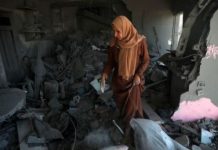
Dec. 5 (UPI) — Israeli ground forces said Tuesday they had surrounded Gaza‘s largest refugee camp after conducting a raid on a Hamas command center in the settlement in which they found “observation and control materials,” weapons and maps.
Troops were continuing to operate in the area of the Jabalya Camp, north of Gaza City, after earlier targeting other Hamas strongholds, destroying enemy military infrastructure and capturing key military posts used to launch attacks on Israeli forces, Israel Defense Forces said in a news release.
The action, coinciding with a ramping up of ground operations across the strip and expanded evacuation orders, came as aid agencies urged Israel to avoid steps that would worsen a “catastrophic” situation, with the United Nation’s agency for Palestinian refugees confirming another 19 of its workers had been killed.
“130 UNRWA colleagues have now been killed since 7 October,” the United Nations Refugee Works Agency said in its daily update.
Nearly 1 million internally displaced people were sheltering in 99 of its facilities in central and southern Gaza, including 64 in and around Khan Younis and Rafah, UNRWA added, with just under 1.2 million people sheltering in 156 UNRWA installations across all five governorates of the strip, including in the north and Gaza City.
United Nations and other international and humanitarian agencies have been warning about the worsening conditions in Gaza since the war began Oct. 7.
But Monday’s pleas come on the heels of the collapse of a weeklong truce between Hamas and Israel that has heightened fears of a deepening conflict.
That scenario appeared to be unfolding over the weekend as the Israeli military expanded ground operations and ordered residents near the southern Gazan city of Khan Younis to evacuate.
Lynn Hastings, the U.N.’s humanitarian coordinator for the occupied Palestinian territory, said some 700 Palestinians had been killed since Friday.
The new evacuation orders for southern Gaza were, she said, pushing tens of thousands of more people into even more desperate situations.
“If possible, an even more hellish scenario is about to unfold, one in which humanitarian operations may not be able to respond,” Hastings said in a statement.
According to a Monday statement from spokesman Stephane Dujarric, U.N. Secretary-General Antonio Guterres was “extremely alarmed” by the resumption of fighting and ground operations by the Israeli forces.
He called on Israeli forces to “avoid exacerbating the already catastrophic humanitarian situation in Gaza and to spare civilians from more suffering.”
“Civilians — including health workers, journalists and U.N. personnel — and civilian infrastructure must be protected at all times,” Dujarric said on behalf of Guterres.
At a press conference, Dujarric told reporters the U.N.’s office for humanitarian affairs is warning that “the current situation” was preventing its personnel from addressing the needs of the people in Gaza.
While there were “limited aid distributions” in the Rafah governorate in southern Gaza, in nearby Khan Younis, “aid distribution had largely stopped due to the intensity of hostilities,” he said.
Other “grave” concerns include the spread of waterborne diseases due to the consumption of unsafe water, especially in northern Gaza, where the water desalination plants and pipelines from Israel have been shut down, Dujarric said.
“There has been almost no improvement in the access of residents in the north to water for drinking and domestic purposes for weeks,” he said.
“And the World Food Program warns that, eight weeks into the war, there is a big risk of famine for all of Gaza’s people, especially for those with chronic diseases, older persons, children and people living with disabilities.”
World Health Organization Director-General Tedros Adhanom Ghebreyesus on Monday said he was been informed by IDF that the organization had 24 hours to remove supplies from their southern Gaza medical warehouse before “ground operations will put it beyond use.”
“We appeal to Israel to withdraw the order, and take every possible measure to protect civilians and civilian infrastructure, including hospitals and humanitarian facilities,” he said in a statement.
In the strongest words from a U.N. official on Monday, head U.N. emergency relief coordinator Martin Griffiths demanded that the fighting stop, describing the situation in Gaza as a “blatant disregard for basic humanity.”
“Every time we think things cannot get any more apocalyptic in Gaza, they do,” he said in a statement.
“People are being ordered to move again, with little to survive on, forced to make one impossible choice after another. NOWHERE IS SAFE IN GAZA,” he said. “Not hospitals, not shelters, not refugee camps. No one is safe. Not children. Not health workers. Not humanitarians.”
Some 1,200 Israelis were killed Oct. 7 when Hamas launched a surprise and bloody attack on the south of the country.
In response, Israeli forces have launched incessant airstrikes on Gaza and a ground invasion that preceded the evacuation of northern Gazans to the southern half of the enclave.
Some 1.9 million Gazans, representing 80% of the strips’s population, have been internally displaced, according to U.N. estimates, while the Hamas-controlled Palestinian Health Ministry said Monday that the death toll had reached nearly 16,000, with 70% of the victims being women and children.






